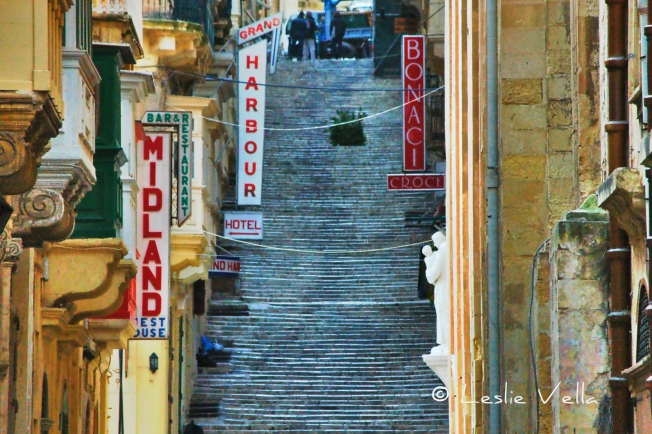
“Adieu, ye cursed streets of stairs, how surely he who mounts you swears”
Thus did Lord Byron describe the stepped streets of Valletta during his twenty day visit to Malta between August 31 and September 19, 1809 when he was forced into an extended stay, mainly due to quarantine following an outbreak of yellow fever in his previous port of call.
Following a few miserable days on board, made worse by the customary September hot and humid weather conditions, he was eventually allowed to disembark and visit Valletta. At that time, the best way to reach upper Valletta on foot was via an interminable staircase which started near today’s fish-market (the infamous Nix-Mangiaris steps) and climbed steeply until they linked with the stepped part of St. Ursula Street all the way to Castille Square.
Byron suffered from a limp, and having to negotiate Valletta’s stepped streets in the sweltering humidity of September must have been a huge effort which stressed him to the point of putting pen to paper to create the spiteful, nevertheless immortal, lines quoted above.

But this short essay is not about Byron’s short sojourn but about Valletta’s stepped streets. The streets are today taken for granted by most Maltese as an integral part of the City’s street-scape.
Valletta is built on a spit of land jutting between two deep-water harbours. A nineteenth century visitor once described Valletta as a city built “on a hog’s back, a narrow but high neck of land dividing the Grand Harbour from the Quarantine Harbour”. The same visitor vividly goes on to describe the City’s main streets as running “in parallel lines along the said hog’s back”, while being regularly intersected “by others which run up and down its steep sides”. He then concludes by stating that, “in some parts they are so steep that flights of steps take the place of the carriage-way”.

When the Knights of St John were planning the city, as a modern renaissance town combining the best of military architecture together with the latest trends in street layout and infrastructural design, they apparently tried, as much as possible, to minimise the annoying limitations brought about by the “hog’s back” contours of the Xiberras Peninsula.
In fact they managed to use rubble to flatten as much as possible of the area between City Gate and St. George’s Square where they built the Grandmaster’s Palace together with an almost similar stretch of Merchants Street except for the hilly upper part which led to Castille Square.
As to the steep side streets: the only way they could negotiate these impossible gradients was to use steps, creating a practical way to make otherwise difficult slopes negotiable by pedestrians. Some of the streets were stepped across their entire width while others had a smooth surface but had pavements (sidewalks for our American readers) made of steps.

Given the tendency of most Maltese-sourced masonry to become polished and very slippery upon extensive use, the designers countered this by using a very scarce, today almost exhausted, source of hardstone: a particularly hard type of coralline limestone known colloquially as żonqor for the steps to ensure durability and a non-slip surface. It is, in fact, amazing that these stone surfaces, evenly pitted with a pickaxe to provide a better grip, remain intact after hundreds of years of use!
If you are a local who regularly walks past these steps and stepped streets with a sense of déjà-vu, do pause for a moment to admire their style and practicality. And if you are a visitor, do make sure to spend some time to experience negotiating these stepped streets which give Valletta yet another unique touch to the many it surprisingly contains within its minuscule dimensions.

So well written! Thank you for sharing so generously
Thank you Rosa. You just made my day!
Makes me homesick for those steps! I so look forward to your informative interesting email. Thank you.
Thank you Alice! My new year’s resolution is to start writing again!! Keep in touch.
Enjoyed reading this so much! Thank you. I grew up in Malta and will be returning for a short visit in 5 weeks. I will be staying in Valletta this time. Have you written about Mdina, Balzan or any other part of Malta? Would love to read more.
Thanks for your kind comments Elizabeth! The blog does have a search function which you should be able to use. So just type in the place name and the relevant write-up, if available, will appear! Hope you will enjoy your next visit. Leslie